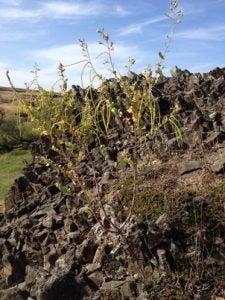Evolution of the seasonal niche in California Jewelflowers (Streptanthus)
 In a group of native California wildflowers (Streptanthus, s.l.), we are studying life history timing in response to environmental cues and how those responses interact with patterns of local environmental variation to drive the evolution of the seasonal niche. We are doing this by investigating germination and flowering in response to cues such as seasonal rains, temperature, and photoperiod and exploring how those responses have evolved across the clade. Further, we are studying how those responses affect fitness and population dynamics in the face of a changing climate, using a combination of field studies, herbarium specimens, and common garden experiments. These studies will be used to parameterize process-based models to predict life history timing as a function current and future climate and demographic models to explore population dynamics in response to various climate scenarios. Link to NSF abstract.
In a group of native California wildflowers (Streptanthus, s.l.), we are studying life history timing in response to environmental cues and how those responses interact with patterns of local environmental variation to drive the evolution of the seasonal niche. We are doing this by investigating germination and flowering in response to cues such as seasonal rains, temperature, and photoperiod and exploring how those responses have evolved across the clade. Further, we are studying how those responses affect fitness and population dynamics in the face of a changing climate, using a combination of field studies, herbarium specimens, and common garden experiments. These studies will be used to parameterize process-based models to predict life history timing as a function current and future climate and demographic models to explore population dynamics in response to various climate scenarios. Link to NSF abstract.
Collaborators: Sharon Strauss, Johanna Schmitt, Julin Maloof, Megan Bontrager
Life history evolution in Streptanthus tortuosus



In plants, fitness in different environments depends on three critical life history transitions: 1) when to germinate, 2) when to switch from vegetative growth to reproduction, and 3) whether to reproduce once and die (semelparity) or survive to reproduce again in later years (iteroparity). We are studying all three of these transitions, how they influence each other, and how coordinated or contingent life history strategies have evolved in response to past and current climate, as well as what that means for life history evolution and population dynamics under future climate change. We are investigating this using a really cool native wildflower, which exhibits remarkable variation within and among populations in life history schedules, including timing of germination as well as the timing of flowering (annual vs perennial) and the frequency of flowering (semelparous vs. iteroparous), which is influenced by the timing of germination triggering rains, seasonal temperature, and summer drought. As part of this project, we are conducting long-term demographic monitoring of multiple populations across an elevational gradient as well as field and common garden experiments.
Collaborators: Johanna Schmitt, Julin Maloof, Megan Bontrager
Germination strategies in Sonoran Desert Winter Annuals

Deserts are a classic example of harsh, variable environments in which we expect germination strategies to be critical for individual fitness and population dynamics. Using long-term demographic data for the Sonoran Desert winter annual community, we have explored the consequences for germination timing for fitness and population dynamics, as well as the roles of bet hedging and plasticity in the evolution of these strategies. Further, we are studying how climate change will influence population dynamics, whether bet hedging and plasticity can buffer the effects of change, and the potential role of contemporary evolution for persistence of these populations in the face of change using long-term data, theory, and empirical studies.
Collaborators: Larry Venable, Sarah Kimball, Hanna Kokko, Sebastian Schreiber, Andy Sih


